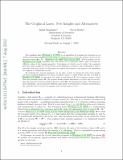The graphical lasso: New insights and alternatives
Author(s)
Mazumder, Rahul; Hastie, Trevor
DownloadMazumder-2012-The graphical lasso.pdf (352.3Kb)
PUBLISHER_POLICY
Publisher Policy
Article is made available in accordance with the publisher's policy and may be subject to US copyright law. Please refer to the publisher's site for terms of use.
Terms of use
Metadata
Show full item recordAbstract
The graphical lasso [5] is an algorithm for learning the structure in an undirected Gaussian graphical model, using ℓ[subscript 1] regularization to control the number of zeros in the precision matrix Θ = Σ[superscript −1] [2, 11]. The R package GLASSO [5] is popular, fast, and allows one to efficiently build a path of models for different values of the tuning parameter. Convergence of GLASSO can be tricky; the converged precision matrix might not be the inverse of the estimated covariance, and occasionally it fails to converge with warm starts. In this paper we explain this behavior, and propose new algorithms that appear to outperform GLASSO.
By studying the “normal equations” we see that, GLASSO is solving the dual of the graphical lasso penalized likelihood, by block coordinate ascent; a result which can also be found in [2]. In this dual, the target of estimation is Σ, the covariance matrix, rather than the precision matrix Θ. We propose similar primal algorithms P-GLASSO and DP-GLASSO, that also operate by block-coordinate descent, where Θ is the optimization target. We study all of these algorithms, and in particular different approaches to solving their coordinate sub-problems. We conclude that DP-GLASSO is superior from several points of view.
Date issued
2012Department
Massachusetts Institute of Technology. Operations Research CenterJournal
Electronic Journal of Statistics
Publisher
Institute of Mathematical Statistics
Citation
Mazumder, Rahul, and Trevor Hastie. “The graphical lasso: New insights and alternatives.” Electronic Journal of Statistics 6, no. 0 (2012): 2125-2149. http://dx.doi.org/10.1214/12-EJS740.
Version: Final published version
ISSN
1935-7524